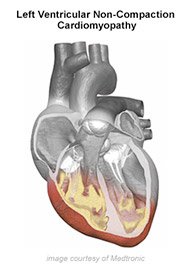LEFT VENTRICULAR NONCOMPACTION (LVNC)

Left ventricular noncompaction cardiomyopathy (LVNC) is a relatively new subtype being recognized in children. Known as noncompaction cardiomyopathy, isolated ventricular noncompaction cardiomyopathy, and spongiform cardiomyopathy, it is a rare form of cardiomyopathy.
With LVNC, the heart muscle appears to have a spongy or noncompacted appearance. Because the heart has failed to transform from spongy muscle fibers to compacted solid muscle during fetal development, deep grooves (trabecular recesses or trabeculations) appear in the heart muscle wall of the main pumping chamber (left ventricle). Noncompaction can present with normal heart function or with heart dysfunction where the heart muscle does not squeeze normally and there is poor contraction and/or poor filling of the heart.
When LVNC occurs with normal left ventricular thickness, size and function, it is called isolated LVNC. LVNC can occur in combination with abnormalities in heart squeeze (dilated form of LVNC) or in heart relaxation (hypertrophic or restrictive form of LVNC). Noncompaction may also involve the right lower chamber of the heart (right ventricle). The course of the disease and outcomes will depend on the LVNC subtype and prescribed treatment.
It is unknown what causes the disruption in heart development to cause noncompaction. LVNC has been classified as genetic in origin and several genes linked to other forms of cardiomyopathy are thought to be associated with this condition.
